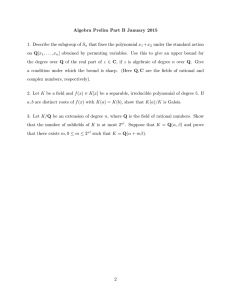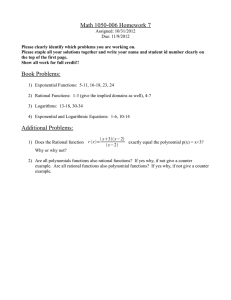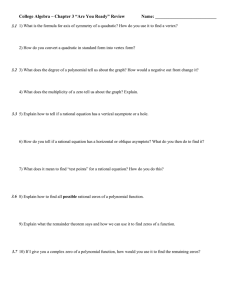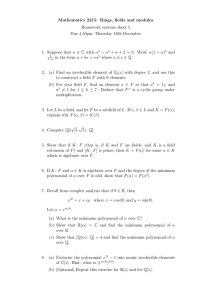14. Rational canonical form 1. If the characteristic polynomial of T
advertisement
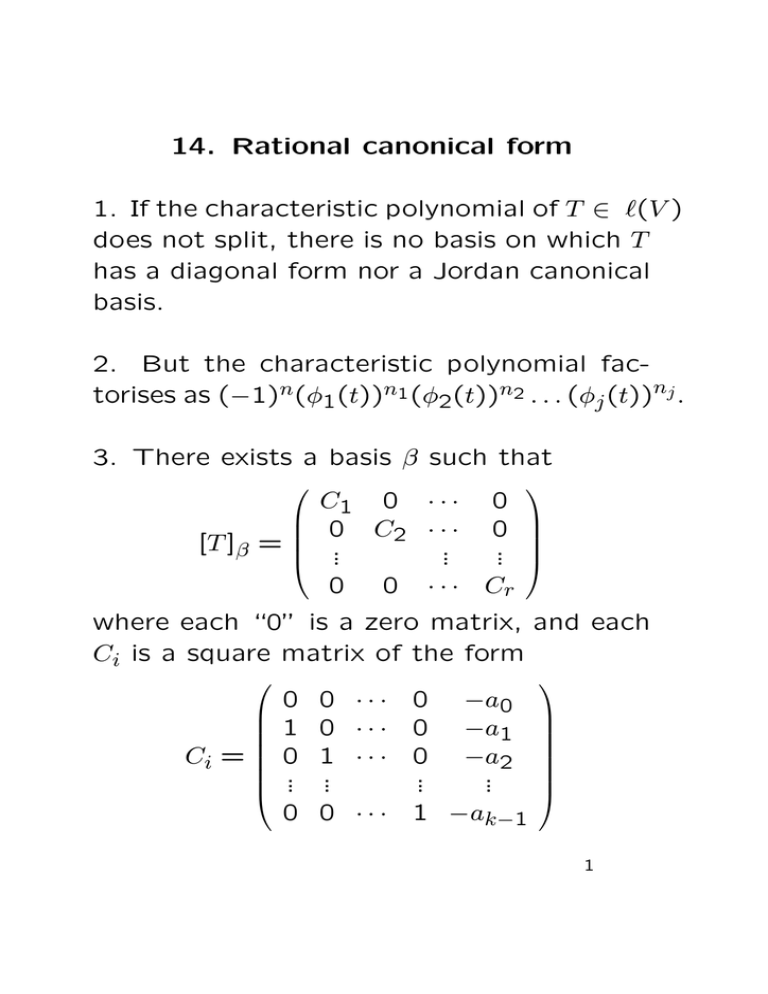
14. Rational canonical form
1. If the characteristic polynomial of T ∈ `(V )
does not split, there is no basis on which T
has a diagonal form nor a Jordan canonical
basis.
2. But the characteristic polynomial factorises as (−1)n(φ1(t))n1 (φ2(t))n2 . . . (φj (t))nj .
3. There exists a basis β such that
[T ]β =
C1 0 · · · 0
0 C2 · · · 0
...
...
...
0 0 · · · Cr
where each “0” is a zero matrix, and each
Ci is a square matrix of the form
Ci =
0
1
0
...
0
0
0
1
...
0
· · · 0 −a0
· · · 0 −a1
· · · 0 −a2
...
...
· · · 1 −ak−1
1
Definitions
A polynomial f (t) is called monic if its
leading coefficient is 1.
If f (t) has positive degree and cannot be
expressed as a product of positive-degree
polynomials with coefficients in the field,
we call f (t) irreducible.
A matrix of the form Ci (previous slide) is
called a companion matrix of the monic
polynomial
a0 + a1t + . . . + ak−1tk−1 + tk .
Use the notation Cx for the T -cyclic subspace generated by x ∈ V . If dim(Cx) = k,
then {x, T (x), T 2(x) . . . , T k−1(x)} is a basis
for Cx called the T -cyclic basis generated
by x, denoted βx. We have that ∃x ∈ V s.t.
Ci = [TCx ]βx .
2
A matrix representation of the form [T ]β
(from the first slide) is called a rational
canonical form of T , and the basis β is
called a rational canonical basis.
Each Ci in the rational canonical form is a
companion matrix of a polynomial (φ(t))m
such that φ(t) is an irreducible monic divisor of the characteristic polynomial and
0 < m ∈ Z.
Main result
For every linear operator on a finite dimensional vector space, there exists a rational
canonical basis and hence a rational canonical form.
Main problem
Find a rational canonical basis.
3
Definition
Let T be a linear operator on a finite dimensional vector space V with characteristic polynomial
(−1)n(φ1(t))n1 (φ2(t))n2 . . . (φk (t))nk
where the φi(t) are distinct irreducible monic
polynomials and 0 < ni ∈ Z. For 1 ≤ i ≤ k
we define
Kφi = {x ∈ V | (φi(T ))p(x) = 0, some 0 < p ∈ Z}.
Theorem
β is a rational canonical basis if and only
if β is the disjoint union of T -cyclic bases
βvi , where each vi lies in Kφ for some irreducible monic divisor φ(t) of the characteristic polynomial of T .
4
Example
T ∈ `(R8), β = {v1, v2, . . . , v8} such that
[T ]β =
0 −3 0 0 0
0 0
0
1
1 0 0 0
0 0
0
0
0 0 0 0 −1 0
0
0
0 1 0 0
0 0
0
0
0 0 1 0 −2 0
0
0
0 0 0 1
0 0
0
0
0 0 0 0
0 0 −1
0
0 0 0 0
0 1
0
Let φ1(t) = t2−t+3 and φ2(t) = t2+1. The
diagonal blocks are companion matrices of
the polynomials φ1(t), (φ2(t))2 and φ2(t).
5
Definition
Let T ∈ `(V ) for f.d. V . A polynomial p(t)
is called a minimal polynomial of T if p(t)
is a monic polynomial of least degree such
that p(T ) = T0.
Theorem
Suppose that the minimal polynomial of
T ∈ `(V ) (f.d. V ) is
p(t) = (φ1(t))m1 (φ2(t))m2 . . . (φk (t))mk
where the φi(t) are distinct irreducible monic
factors of p(t) and 0 < mi ∈ Z. Then
Kφi = ker((φi(T ))mi ).
If γi is a basis for Kφi , then γ1 ∪ γ2 ∪ · · · ∪ γk
is a basis for V . Moreover, if each γi is a
disjoint union of T -cyclic bases, then γ is a
rational canonical basis.
6
How to form a rational canonical basis associated with T ?
1. Determine the characteristic polynomial
of T .
2. Determine the minimal polynomial of T .
3. Find T -cyclic bases associated to each
Kφi .
4. Form a rational canonical basis β of V
as a disjoint union of these T -cyclic bases.
7
Example
T ∈ `(P3(R)) s.t. T (f (x)) = f (0)x − f 0(1).
Let β = {1, x, x2, x3}
A = [T ]β =
0 −1 −2 −3
1
0
0
0
0
0
0
0
0
0
0
0
⇒ characteristic polynomial (t2 + 1)t2.
Note
A2
+I =
0
0
0
0
0
0
0
0 −2 −3
0
1
0
0
0
1
so (A2 + I)A = 0.
The minimal polynomial is therefore
(t2 + 1)t.
8
To find Kt2+1:
Find all v s.t. (A2 + I)v = 0.
0
0
0
0
0
0
0
a
0 −2 −3
b
0
1
0 c
0
0
1
d
=
0
0
0
0
⇒ a, b free and c, d = 0
0
1
0 1
⇒ ,
0 0
0
0
is a basis for Kt2+1
which is a T -cyclic basis.
9
To find Kt:
Find all v s.t. Av = 0.
0 −1 −2 −3
a
1
0
0
0
b
0
0
0
0 c
0
0
0
0
d
=
0
0
0
0
⇒ a = 0 and b = −2c − 3d
0
0
−2 −3
⇒
is a basis for Kt
,
0
1
0
1
which is the union of two disjoint bases with
one vector each (since both are eigenvectors).
10
A rational canonical basis for T (in coordinate vector form) is
1
0
0 1
⇒ ,
0 0
0
0
,
0
−2
1
0
,
0
−3
0
1
which in terms of vectors in P3(R) is
{1, x, x2 − 2x, x3 − 3x}.
The corresponding rational
is
0 −1 0 0
1
0 0 0
0
0 0 0
0
0 0 0
canonical form
11
Example
Ã
0 1
−1 1
T ∈ `(M2(R)) s.t. T (A) =
(Ã
Let β =
1 0
0 0
A = [T ]β =
! Ã
,
0
0
0
0
−1
0
0 −1
0 1
0 0
1
0
1
0
! Ã
,
0
1
0
1
0 0
1 0
!
A
! Ã
,
0 0
0 1
⇒ characteristic polynomial (t2 − t + 1)2.
−1
0 1 0
0 −1 0 1
Note A2 =
−1
0 0 0
0 −1 0 0
so A2 − A + I = 0.
The minimal polynomial is therefore
t2 − t + 1.
12
!)
Kt2−t+1 = R4 which has standard basis
1
0
0 1
,
0
0
0
0
0
0 0
,
1 0
,
0
0
1
We seek to turn this into a union of disjoint
T -cyclic bases.
Note
0
0
0
0
−1
0
0 −1
1
0
1
0
0
1
0
1
and
0
0
0
0
−1
0
0 −1
1
0
1
0
= −
0
1
0
1
1
0
0
0
1
0
0
0
=
0
0
−1
0
+
0
0
−1
0
=
0
0
−1
0
−1
0
−1
0
13
Also note
0
0
0
0
−1
0
0 −1
1
0
1
0
0
1
0
1
0
1
0
0
=
0
0
0
−1
and
0
0
0
0
−1
0
0 −1
1
0
1
0
= −
1
0
0 0
⇒ ,
0 −1
0
0
0
1
0
1
0
1
0
0
0
0
0
−1
+
=
0
0
0
−1
0
1
,
,
0
0
0
−1
0
−1
0
0
0
−1
are two T -cyclic bases whose union gives a
rational canonical basis for Kt2−t+1.
14
A rational canonical basis is
(Ã
1 0
0 0
! Ã
,
0 0
−1 0
! Ã
,
0 1
0 0
! Ã
,
0
0
0 −1
!)
with corresponding rational canonical form
0 −1 0
0
1
1 0
0
0
0 0 −1
0
0 1
1
15
Example
Find the rational canonical form of the matrix
0
2 0 −6 2
1 −2 0
0
2
A=
1
0
1
−3
2
1 −2 1 −1 2
1 −4 3 −3 4
and a corresponding rational canonical basis.
Hint: the characteristic polynomial is
−(t2 + 2)2(t − 2).
16

